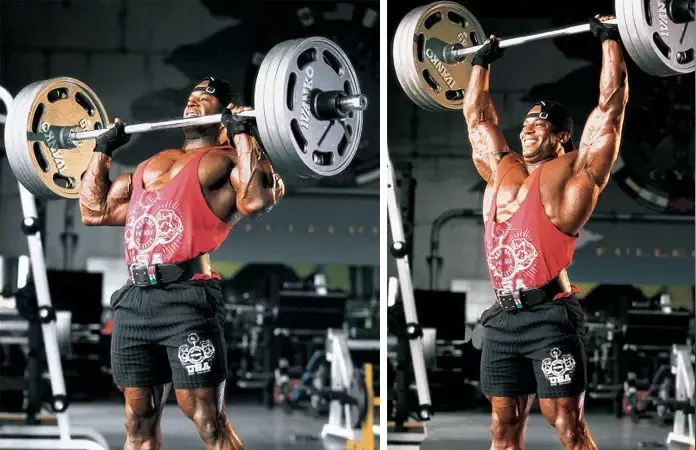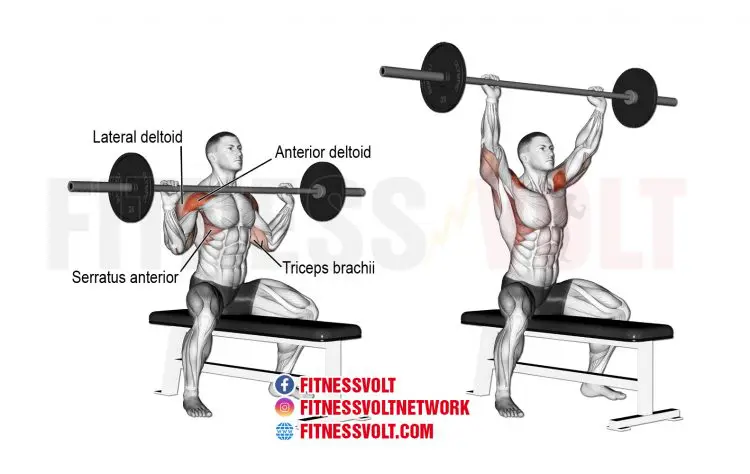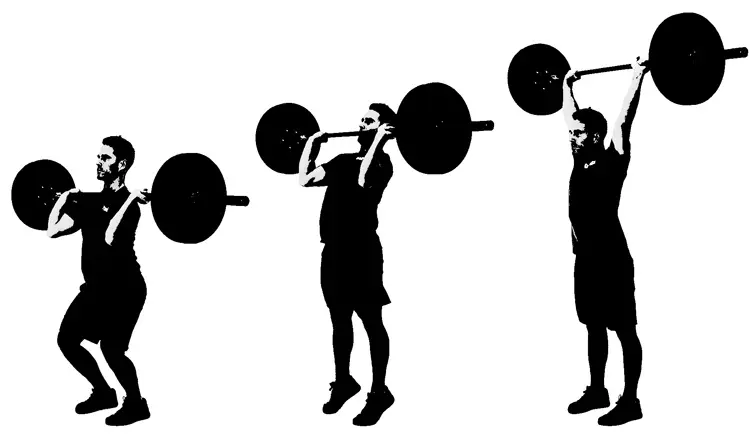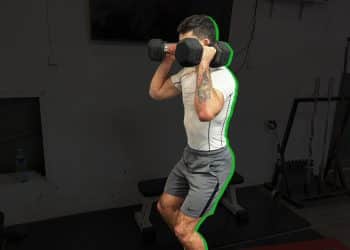The overhead press is a classic strength training exercise. Also known as the shoulder press or military press, until the 1960s, this move used to be one of the Olympic lifts. It’s no longer contested in Olympic lifting competitions, but it’s still a regular event in most strongman meets.
As well as being a test of strength, the overhead press is one of the best ways to develop a powerful upper body. It targets your deltoids and works your upper traps and triceps too. Because overhead presses are often done while standing, it’s also a decent core exercise.
There is no denying the effectiveness of the overhead barbell press, but if that’s the only pressing exercise you do for your delts, your progress will soon stall. To help you avoid workout ruts, we’ve put together a list of the 15 best overhead press variations.
We’re not talking machine or dumbbell presses here but variations of the classic standing barbell overhead press. Using dumbbells or a machine for your presses would be an alternative and not a variation.
So, if you’ve had enough of the conventional barbell overhead press, give one of our best 15 variations a try.
Level Up Your Fitness: Join our 💪 strong community in Fitness Volt Newsletter. Get daily inspiration, expert-backed workouts, nutrition tips, the latest in strength sports, and the support you need to reach your goals. Subscribe for free!
The Best Overhead Press Variations
Whether you want to build muscle, get stronger, or increase your overhead press performance, these variations will help. Use them in place of conventional overhead presses or as a secondary assistance exercise after your main workout.
Or, if you usually do overhead presses twice a week, use your choice of alternatives to make up your second workout.
1. Seated overhead press
A lot of exercise purists say that real overhead presses should be done standing. But, for some exercisers, sitting is a better option. Seated overhead presses take some stress off your lower back and also stop you from using your legs to cheat the weight up. If you want to take your lower body out of the overhead press, doing them seated is the way to do it.
If sitting perfectly vertical proves uncomfortable, try using a very slight incline – say about 10-15 degrees. This is more joint-friendly but still ensures your shoulders get an effective workout.
Learn how to do seated overhead presses here.
2. Z-press
Z-presses are a type of seated overhead press, but you don’t need a bench for this variation. Instead, you sit on the floor with your legs outstretched.
This move is great for core strength and lower body flexibility. It’s a challenging exercise so start light and only increase the load if you can do all your reps with perfect form.
How to do it:
- Sit on the floor with your legs straight and spread wide for balance. Adopt a tall posture. Hold a barbell across your shoulders as you would for regular overhead presses.
- With your core braced, and without leaning forward or back, press the bar up and overhead.
- Lower the bar back to your shoulders and repeat.
- If you have tight hamstrings and cannot keep your legs out straight, sit on a 4 to 8-inch platform. This will reduce the angle of your hips and allow you to sit with straight knees.
3. Push press
To the uninitiated, the barbell push press looks like you are cheating. That’s because, in this exercise, you use your legs to help you drive the weight up and overhead. Rather than cheating, this variation means you can lift heavier weights, so it’s useful for building strength and power.
How to do it:
- Hold your barbell in front of your shoulders. Lift your chest and pull your shoulders down and back. Brace your core and stand with your feet between shoulder and hip-width apart.
- Bend your knees and descend into a quarter-depth squat.
- Explosively extend your legs and use this momentum to help you push the weight up and overhead to arms’ length.
- Lower the weight back to your shoulders, reset your core and repeat.
4. Thrusters
Barbell thrusters are similar to push presses in that you use your legs to help you lift the weight up and overhead. However, where push presses involve a relatively small leg movement, thrusters use a full front squat. This turns what is usually an upper body exercise into a whole-body movement.
You can do thrusters with light to moderate weights for medium to high reps for hypertrophy and conditioning or with heavy weights for low reps for strength and power. Of course, to do thrusters properly, you also need to be a good front squatter, so only attempt this exercise if you have mastered this prerequisite lift.
How to do it:
- Hold your barbell in front of your shoulders. Lift your chest and pull your shoulders down and back. Brace your core and stand with your feet between shoulder and hip-width apart.
- Bend your knees and squat down until your thighs are roughly parallel to the floor. Keep your core braced and torso upright.
- Stand up and out of the squat, using this momentum to help you press the weight up and overhead.
- Lower the bar back to your shoulders, reset your core and repeat.
5. Power clean and overhead press
The clean and press is a simplified version of the clean and jerk, one of the events in Olympic lifting. It’s also an alternative way to start your overhead presses if you don’t have access to a squat rack or power cage.
You can do a clean and strict barbell overhead press with no leg drive or a clean and push-press. Of course, to do either of these exercises, you need to master the power clean.
Learn how to do this powerful exercise in this guide.
6. Pin press
The pin press is a very strict overhead pressing variation where each rep starts from a dead stop. This eliminates the eccentric/concentric stretch reflex and forces you to begin your rep with a violent burst of power and acceleration.
Level Up Your Fitness: Join our 💪 strong community in Fitness Volt Newsletter. Get daily inspiration, expert-backed workouts, nutrition tips, the latest in strength sports, and the support you need to reach your goals. Subscribe for free!
It’s a good exercise for developing upper body explosiveness. You can do standing or seated pin presses as preferred.
How to do it:
- Seated or standing, using a squat or power rack, set your bar to shoulder-height. Grip the bar as normal. Brace your core and pull your shoulders down and back.
- Drive the bar up and out of the rack to arms’ length.
- Lower the bar back down to the pins and allow it to settle for a second or two.
- Reset your core and repeat.
7. Scrape the rack press
The scrape the rack press increases deltoid activation. Instead of just pushing the bar upward, you also need to press it forward too. This maximizes anterior deltoid recruitment and tension, making it an excellent exercise for building bigger shoulders.
Be warned; this variation can chip the paint off your power rack, so don’t do it if your gym manager is touchy about that sort of thing. However, you can avoid this problem by putting some athletic tape on your barbell and the power rack you’re using.
How to do it:
- Seated or standing, set your barbell on J-hooks in a power rack at shoulder height. Grip the bar as normal.
- Pushing the bar against the vertical frame of the power rack, press it up and overhead. Make sure you push it forward against the rack as well as upward. Scrape that rack! Take care not to hyperextend your lumbar spine.
- Lower the bar back down and repeat.
8. Partial press
Partial presses reduce your range of motion, which means you should be able to lift heavier weights. This is a good exercise for overloading your delts and triceps. You can do partial presses seated or standing is preferred.
To do this overhead press variation, lower the bar to the top of your head rather than your shoulders. Take care not to lower the bar too quickly, or you may inadvertently hit and hurt your head.
9. Overhead press with kettlebells
The overhead press is an inherently stable exercise. While you need to use your core and shoulder stabilizers to keep the bar on the right path, balance isn’t usually too much of an issue.
That all changes with this variation. Instead (or as well as) using weight plates, you hang kettlebells from your barbell. The weights will move as you train, forcing you to work much harder on stabilizing the load. This is a useful rehab exercise after a shoulder injury and will also improve your regular overhead press performance.
To do this exercise, simply hang kettlebells from your bar, using collars to stop them from sliding off the ends. Alternatively, you can suspend your kettlebells using resistance bands, which will create an even more unstable load.
10. Overhead press with bands/chins
Overhead pressing with bands or chains increases the resistance as you extend your arms. This type of training is called accommodating resistance. Using bands or chains increases the tension on your triceps and encourages you to drive the bar up powerfully off your shoulders, training you to blast through your sticking points.
Bands and chains work in more or less the same way, but bands are cheaper and lighter, so you can buy a set and keep them in your gym bag. You can use bands or chains in conjunction with many of the other overhead press variations in this article.
11. 3 count eccentric overhead press
You are stronger eccentrically than you are concentrically. This means you can lower more weight than you can lift. Make the most of this by accentuating the lowering part of your overhead presses. Lowering the weight more slowly than you lift it exposes your muscles to more hypertrophy-inducing tension so you can build muscle faster.
To do this overhead press variation, press the bar up as usual but then lower it for a slow and deliberate count of three. Press it up again and repeat. You can also use this method with push-presses, thrusters, and any other overhead press variation.
12. Javelin press
The javelin press is a great way to do unilateral or single-limbed overhead presses with a barbell. Training one arm at a time will help you identify and fix left to right strength imbalances. This overhead press variation is also a very effective core exercise, as you’ll have to work extra hard to stabilize your spine.
How to do it:
- Set your barbell to shoulder-height in a squat or power rack. Stand next to it, sideways on. Hold the bar with a neutral grip, with your palm facing inward. Make sure you grip the exact center of the bar. Brace your core and unrack the bar.
- Without leaning sideways, press the bar up and overhead. Grip it tightly to stop it from tilting or twisting.
- Lower the bar back to your shoulder and repeat.
- Rest and then change sides. Try and do the same number of reps with both arms.
13. Behind the neck press
The behind the neck press is a very controversial exercise. And yet, despite many trainers all-but banning this exercise, it used to be a staple of old-school bodybuilding training. Providing you have healthy, mobile joints, there is no real reason to fear the behind the neck press. It’s a useful overhead press variation. However, if behind the neck presses cause new shoulder pain or make existing shoulder pain worse, it’s best to skip this exercise.
Behind the neck, presses can be done seated or standing. They work best with a wider than shoulder-width grip. Pull your shoulders down and back and keep your chest up, lowering the bar down to your upper traps. Try not to jut your head forward to make space for the bar. Instead, pull the bar backward.
14. Bradford press
The Bradford press is named after American weightlifter Jim Bradford, famed for his huge shoulders and overhead pressing strength. Because this exercise involves a behind the neck component, perform it with caution or avoid it entirely if you have a history of shoulder pain.
This exercise can be done seated or standing. It works best with light to moderate weights and medium to high reps. Chase the pump!
How to do it:
- Set up as usual for barbell overhead presses. With your abs braced, press the bar up.
- As it approaches the top of your head, lift the bar over and then behind your head to the back of your neck. Do not raise the bar higher; it should just skim the top of your head.
- Press the bar from your neck back over your head and then lower it to your shoulders.
- That’s one rep; keep going!
15. Cuban press
The Cuban press was originally developed by Cuban Olympic weightlifters. It’s an all-in-one shoulder exercise that works all three deltoid heads and the biceps and triceps too. It’s also a decent upper traps exercise. While this exercise is often done using dumbbells, it works equally well with a barbell.
The Cuban press is not an exercise for heavy weights. Instead, move slowly and deliberately and use light to moderate loads. Focus on generating lots of muscle tension and getting a great pump.
How to do it:
- Hold your barbell in front of your legs using a slightly wider than shoulder-width, overhand grip. Stand up tall, with your shoulders pulled down and back.
- Bend your arms and pull the bar up the front of your body to your sternum. Keep your elbows above your hands.
- Next, rotate the bar forwards and up to your forehead.
- Press the bar up and overhead to arms’ length.
- Lower the bar down by reversing the movement.
More Resources on Shoulder Exercises:
- Best Rear Deltoid Exercises
- Essential Cable Shoulder Exercises
- Best Front Delt Exercises
- Best Side Delt Exercises
- Best Shoulder Exercises For Powerful Delts
- Build Bigger Shoulders: Overhead Press Hypertrophy
- 13 Ways to Avoid Shoulder Pain
Wrapping Up
The overhead barbell press is a classic strength training exercise. To many, it’s the fourth power lift, after the squat, bench press, and deadlift. It’s a proven shoulder builder and a traditional test of upper body strength. It also predates the bench press by several centuries!
But, just because an exercise is so well-loved doesn’t mean you have to follow the herd and do it the same way as everyone else. Exercise variation is a necessary part of effective program design. If you do the same exercises all the time, your progress will soon grind to a halt.
With 15 new overhead barbell press variations, your shoulder workouts never need to be repetitive or boring. Use these tried and tested overhead press variations to keep your workouts fresh, enjoyable, and productive!













